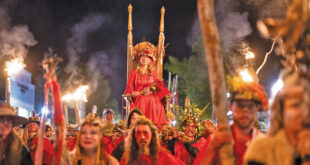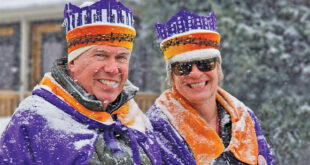“It is better to be wild than good.”
—Marcie Telander
By Dawne Belloise
There’s a reason Crested Butte is the designated Wildflower Capital of the entire state of Colorado. Look around our valley and mountains and you’ll see a profusion of colors throughout the summer, especially during the height of the season in July. Whether you’re out hiking at high alpine splendor or the magnificent Upper or Lower Loop trails at town’s edge, it’s fun to know some of the origins and lore of the local flora.
Long before the area was settled as a mining town, and now a resort destination, the Ute tribe considered Crested Butte’s mountains and valley to be sacred for all its bounty. Marcie Telander is a long-time local storyteller, writer and poet who was the one-time host of the “Fairy Houses, Flower Lore and the Native Spirit of Plants” event during the Crested Butte Wildflower Festival. She explains the special and spiritual connection of the Ute to these mountains.
“They were very nomadic, coming from a more arid ecosystem. They would come to the place of the pavant, the Ute word for ‘where the sacred waters come together,’ where they would have ceremonies and treat with other tribes. It was a considered a place of healing and treating. It was a place that herbs were gathered, treaties were made, children were named, marriages were arranged, and ceremonies were celebrated,” says Telander.
With the abundance of water and wetlands in this valley, Marcie imagines that the Utes would gather those plants that were not available in their own tribal lands, like mint and various healing roots, wild onions, and berries. But how did they know which plants and flowers were beneficial and which were poisonous?
Marcie reveals, “The ancient ethno-botanists, and the very first integrative healers, essentially experimented on themselves with these plant medicines. They were shamans in their communities. This is the way that the first herbalists learned, by taking little tastes of each…it was not a ‘go to’ plant if you keeled over!”
The knowledge was then handed down from generation to generation, across cultures and countries.
Much of Europe has similar plants and flowers that grow in our area and whose lore was passed down to the New World. Kathy Darrow, ecologist and author of Wild About Wildflowers: Extreme Botanizing in Crested Butte explains, “I think every plant has its own lore. In history, most of the plants have lore that goes back to Europe. Species are similar to ones in North America. For instance, Monkshood is a species that occurs in Europe as well as Crested Butte and has a lot of medicinal properties and poisonous properties and fun lore. Aconitum is the genus that name comes from. In the Greek legend, Hercules fought Cerberus, the three-headed dog that guards the gates of hell. The location where they were fighting was a hill in Greece named Aconitus, so the lore says the plant grew from the spit of the dog.”
Another of Kathy’s favorite Greek legends wraps around Parnassia (or bog flower), a flower named after Mount Parnassus, the sacred home of the Greek god Apollo and the nine Muses. “The grass of Parnassus is named after the mountain because it was such a beautiful plant and a gift from the Muses. It’s a subtle plant, and there are a couple different kinds in the Crested Butte area,” Kathy says. Fringe Parnassia has fringes on its five white petals and grows in wetlands on mounds of ruffly green leaves. Kathy says, “They grow in places where you could imagine fairies and Muses.”
The first doctors were actually ancient herbalists and much of today’s lore comes from their ideas about medicines. Determining what plant would be useful to treat an ailment or illness might have been based on the shape of the leaves, or the shape of the roots. “Orchids come from the Latin word ‘orchis,’ which means testicles,” Kathy explains. “Because of the shape of some of the roots, early herbalists suggested that if a pregnant women ate orchid root she would be more likely to have a boy.”
There are at least a dozen different kinds of orchids in the mountains surrounding Crested Butte, including the beautiful Fairy Slipper, Coral Root, Ladies Tresses and Bog Orchid, but be sure to ask which ones are edible if you’re planning to have a boy baby.
Want a baby girl? The Harebell is our Rocky Mountain equivalent to the European flower named Rapunzel—yes, the very same girl in the fairytale. The old story tells that the greedy witch demanded the baby, whom she named Rapunzel, as payment from the father-to-be when he stole the nutritious Rapunzel flower from the witch’s garden. The poor father took the plant only to satisfy his pregnant wife’s craving for it.
In Navajo culture it’s believed that eating Harebells, aka Rapunzel, during your pregnancy will lead to birthing a girl.
Some wildflowers such as Penstemons, for example, are endemic to North America and have no corresponding ancient lore. However, the Indian Paintbrush, which can be found in hues of brilliant reds and oranges to fuchsia and purples, is also endemic to the Western Hemisphere but has a Cherokee story about its origins. The flowers were derived from the Great Spirit as a gift to a young Native American boy who wanted to paint the sunset. Having worked very hard for it, the boy was finally rewarded for his dedication by the Great Spirit, who gave him the brushes of every color of the sunset. As the boy painted his masterpiece he discarded each of the brushes, which then transformed into flowers.
From Persia comes the folktale of the Forget-me-nots, the dainty purple flowers that dot our mountain landscapes. Legend says that an angel and her human lover planted the flowers so that they could enter paradise together as immortals.
Kathy likes the Latin names used for flowers. “They’re very descriptive of the plant family or plant itself. Sometimes they’re just names of botanists and their friends and lovers,” she laughs. “One of my favorite plant family names is the buttercup family Ranunculaceae, which comes from the Latin root ‘rana,’ which means frog, and a lot of buttercups grow in wetlands where there are frogs—hence the name. (Check out the Marsh Marigolds and Monkshood in the wetland areas).
In the original Disney version of Alice in Wonderland, Alice is driven out of a manicured garden by a cultivation of high-bred, snooty flowers because they determine she is but a weed, but alas, a lot of the plants we call weeds, and those we consider to be invasive, are plants that were brought to North America because of their medicinal or edible properties. Kathy relates, “For instance, the Ox-eye Daisy is edible and has medicinal properties and was brought over from Europe in the early 1700s for those reasons but is now considered invasive. It was one of those ‘cure everything’ plants, from headaches to painful childbirths to asthma, and a mineral tonic tea. People planted them on the graves of loved ones. Or dandelions, another classic that was introduced from Europe as an edible plant.”
The perceived enemy of every lawn and garden tender, the dandelion gets its genus name from the Greek word taraxos, which means disorder, and akos, which means remedy. Various Native American groups used dandelions for food, a dermatological aid, a gastrointestinal aid, a cure for sore throats, an analgesic, a blood purifier, a sedative, a laxative, an emetic, a love potion, and a general tonic for good health. Dandelions were used as medicine by Arabian doctors as early as the 10th century. During World War II, many used the dandelion root as a coffee substitute since coffee beans were hard to come by. Today, dandelions have been proven effective as a diuretic, to treat high blood pressure, as a detoxifying herb supporting the liver, kidneys and gallbladder, to relieve constipation, for skin problems such as eczema and psoriasis, and to treat osteoarthritis and gout. It’s an abundant source of potassium and it makes a fine wine, herbal beer and salad as well. Better than a psychic, dandelions can help foretell your future—just by blowing its fluffy umbrella-like seeds away it can reveal if your lover is faithful, how many children you will have, the time of day, how many years you have left, and if your mother wants you home, and you can send a telepathic message if you blow the seeds in that person’s direction. It might even give you the winning lottery numbers. So think twice before you pull that supposed weed.
“Anybody can make up their own wildflower lore and stories because that’s how we learn about plants, when we pass down stories about them,” Kathy encourages and laughs, “Your story is just as relevant as a one-thousand-year-old story.” So go ahead, take a hike amongst the wildflowers and create some lore of your own to pass down to your kids. You could wind up a legend.
For more local wildflower lore and identification get yourself a copy of Kathy Darrow’s book Wild About Wildflowers: Extreme Botanizing in Crested Butte, available at Townie Books (online as well), the Crested Butte Heritage Museum and the Crested Butte Wildflower Festival office. For more information about Marcie Telander and her work visit her online at marcietelander.com. For information on the Wildflower Festival visit: crestedbuttewildflowerfestival.com.
 The Crested Butte News Serving the Gunnison Valley since 1999
The Crested Butte News Serving the Gunnison Valley since 1999




